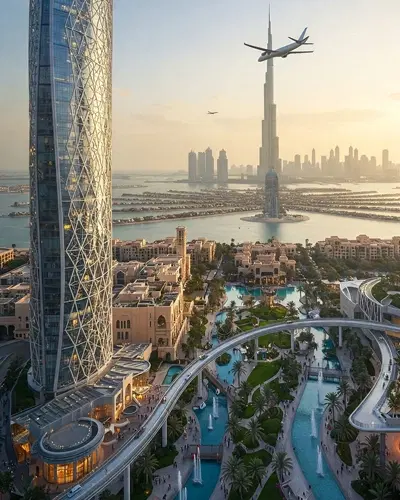Let’s take a closer look at why some areas in Dubai grew faster than others in terms of property value between 2020 and 2025:
1. Dubai Hills Estate
Capital Appreciation: +85%
What Helped It Grow:
- Located right between Downtown and Dubai Marina, making it ideal for families and professionals.
- Many luxury projects launched by top developers, such as Emaar, Ellington, and Sobha, have added value.
- The Dubai Hills Mall, which opened in 2022, became a major lifestyle destination.
Future Outlook: Still growing. Villas are in short supply and in high demand, especially from families looking to live there long-term.
2. MBR City (Mohammed Bin Rashid City)
Capital Appreciation: +73%
What Helped It Grow:
- A massive master-planned area with gated communities and greenery.
- Key projects like District One, Sobha Hartland, and The Sanctuary added prestige.
- Beautiful canal-facing apartments and parks attracted buyers looking for peaceful luxury.
Future Outlook: Prices may rise even more as roads, schools, and metro links are completed.
3. Business Bay
Capital Appreciation: +76%
What Helped It Grow:
- Located right next to downtown, it benefitted from overflow demand.
- Branded towers like Bugatti Residences, Mercedes-Benz Tower, and Binghatti’s luxury launches attracted global investors.
- Popular among investors looking for short-term rental income from luxury tenants.
Future Outlook: Likely to stay in high demand for both rentals and resale till at least 2030.
4. Palm Jumeirah
Capital Appreciation: +66%
What Helped It Grow:
- Home to ultra-luxury properties like Atlantis The Royal and Six Senses Residences.
- Being a man-made island, the land is limited, which keeps demand high.
- Attracted billionaire buyers from Russia, Europe, and India.
Future Outlook: Will remain a high-end hotspot for the world’s richest property seekers.
5. Jumeirah Village Circle (JVC)
Capital Appreciation: +64%
What Helped It Grow:
- Affordable entry prices made it attractive for first-time buyers and investors.
- Many developers offered 1% monthly post-handover payment plans, encouraging off-plan purchases.
- New lifestyle communities with parks, gyms, and retail have improved the quality of life.
Future Outlook: Expect steady growth due to a healthy mix of mid-income and premium properties.
6. Dubai Marina
Capital Appreciation: +60%
What Helped It Grow:
- Famous for its waterfront views, walkability, and nightlife.
- A favourite for tourists, short-term renters, and digital nomads.
- Offers easy access to the beach and has a lively atmosphere year-round.
Future Outlook: Strong resale market, though limited space means future price growth may slow.
7. Arjan
Capital Appreciation: +61%
What Helped It Grow:
- Lower prices made it ideal for budget-conscious investors.
- Close to attractions like the Miracle Garden and near many schools and hospitals.
- Many new projects have been launched with low ticket sizes and high rental yields.
Future Outlook: With future metro connectivity, this area is likely to see gradual and steady growth.
8. Downtown Dubai
Capital Appreciation: +58%
What Helped It Grow:
- A “blue-chip” location with direct views of the Burj Khalifa and Dubai Fountain.
- Consistent demand from international investors who value iconic landmarks.
- The limited number of ready units pushed prices higher.
Future Outlook: Will continue to attract high-end buyers and remain a liquid market (easy to buy and sell).
9. Meydan
Capital Appreciation: +65%
What Helped It Grow:
- Known for branded residences by names like Bugatti and Elie Saab.
- New schools, retail centres, and roads improved the area quickly.
- Properties were cheaper in 2020, giving more room for appreciation.
Future Outlook: Set to grow further with its master-planned layout and increasing interest from investors.
10. Dubai Creek Harbour
Capital Appreciation: +59%
What Helped It Grow:
- The upcoming Creek Tower and stunning waterfront views created strong appeal.
- The Ras Al Khor road upgrade improved access to Downtown Dubai.
- Confidence in Emaar’s development vision attracted long-term investors.
Future Outlook: It is still developing and expected to become one of Dubai’s most sought-after lifestyle destinations in the coming years.
Infrastructure Impact on Appreciation:
One of the biggest reasons behind the rise in property prices across Dubai has been the development of new infrastructure. When a new road, metro line, mall, or school is built in or near a neighbourhood, it usually makes that area more convenient and attractive to live in. As a result, demand for properties in that location increases, and so do the prices.
For example, areas like Dubai Hills Estate saw major growth after the opening of Dubai Hills Mall, which improved shopping and entertainment options. Similarly, new metro lines being planned, like the Blue Line, will make it easier to reach places like Dubai Creek Harbour and Arjan, pushing up property demand in those zones.
Good infrastructure doesn’t just improve living standards; it also adds long-term value to properties. That’s why smart investors often keep an eye on future infrastructure plans before deciding where to buy. The table below lists some standout developments:
Major Dubai Projects and Their Market Impact
| Project |
Beneficiary Areas |
Impact |
| Dubai Metro Blue Line |
Dubai Creek Harbour, Arjan |
Boosts accessibility |
| Al Maktoum Intl Airport Expansion |
Dubai South, Jebel Ali |
Triggers new investment |
| Dubai Hills Mall (2022) |
Dubai Hills Estate |
Retail + lifestyle boost |
| Canal Extension to MBR City |
MBR City, Sobha Hartland |
Adds waterfront value |
| Palm Jebel Ali Relaunch (2023) |
Palm area spillover |
Premium buyer interest |




